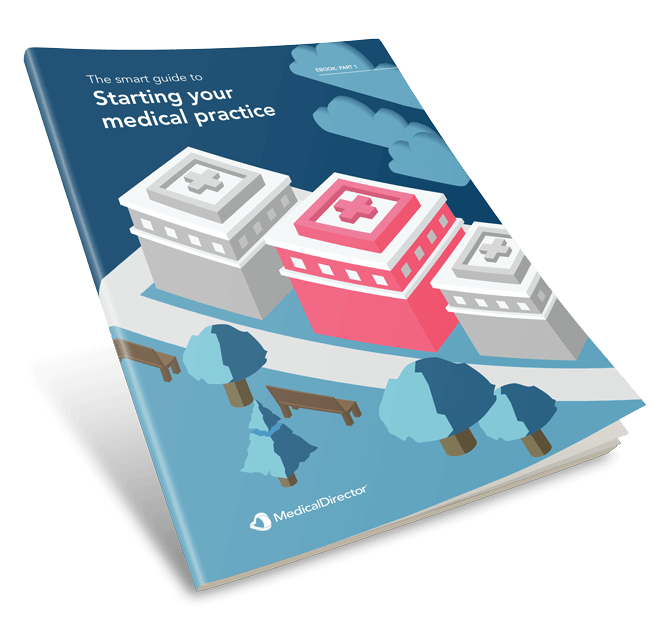Medical practice startup costs – 5 tips to save you money
Starting your own medical practice can be exciting, but for a practice that has healthy cash flow, and can scale and grow, you need to identify and plan for all your start-up costs – so you can avoid as many surprises as possible.
In MedicalDirector’s latest ebook, ‘Calculating the cost of starting your medical practice,’ we reveal how to calculate the costs of starting your practice, as well as some simple ways to cut costs from the start.
In the following article, we’ll summarise five of these important tips to get started on the front foot, including:
- Why you should avoid a one-size-fits-all financial plan. This is because your exact start-up costs will depend on the type of medical practice you’re starting, and the region in which you’re operating.
- The importance of calculating one-time vs ongoing costs. This will help you better manage and set up your budget, and organise your cash flow from the outset.
- How to set realistic expectations. A safe bet is to overestimate both the time and money it takes to start a medical practice, by as much as 10%.
- Using the cloud to cut costs. This can be the ultimate way to save on your medical practice startup costs.
- Ways to minimise staffing and administrative costs. Staffing costs increase each year, so automating can significantly boost efficiency and reduce time and money wasted on manual tasks.
Let’s get started with 5 ways you can save money when it comes to your medical practice startup costs…
Tip 1: Avoid a one-size-fits-all financial plan
Your exact start-up costs will depend on the type of medical practice you’re starting, and the region in which you’re operating. The ‘amount’ of costs in the different categories can also vary across industries and regions.
For example, a specialist practice may need to invest in specialist clinical management software, while a larger general practice would need to invest in a larger IT platform tailored to suit a larger team of doctors and staff.
Tip 2: Calculate your one time vs ongoing costs
Start by identifying which of your costs will be one-off and which will occur more frequently, such as monthly, quarterly or annually. This will help you better manage and set up your budget, and organise your cash flow from the outset. It will also stop you from getting caught out in the future.
There are other important considerations, too. “You will also need to factor in which costs are capital investments, and which may be variable expenses for your practice,” explains Professor (Dr) Martin Samy, founder of the Samy Medical Group in Western Australia.
Here’s a summary of key costs to prompt your thinking:
- Business plan development
- Preliminary accounting and legal advice
- Insurances and licenses
- Property, tenancy/lease bond agreements and property advice
- Design and fitout
- Telephone/internet installation
- Statutory requirements and legal advice
- Power connection
- IT infrastructure plan
- EFTPOS infrastructure
- Clinical equipment/materials/machinery
- Office equipment, fixtures and fittings
- Staff recruitment costs, training costs, and wages
- Market research, marketing material, signage, and a marketing plan.
Tip 3: Set realistic expectations
The fact is, there are many costs to consider when starting a medical practice. It can seem daunting at first when you’re trying to plan for every contingency. Also consider that any unforeseen delays while waiting for your practice to open and generate revenue can impact your cash flow and costs. A flow on effect could mean a significant impact on your practice as a business, and your professional reputation in the industry.
Your safest bet is to overestimate both the time and money it takes to start a medical practice. Some experts recommend adding at least 10% on top of your total costs to cover any miscellaneous expenses or unforeseen fees and charges.
Tip 4: Cut costs with the cloud
According to Prof Samy, starting your practice with the cloud can be the ultimate way to save on your medical practice startup costs. This is because it eliminates the cost of servers, expensive hardware and IT support staff, while reducing significant operational costs and driving efficiencies.
With a paperless cloud software solution, like Helix by MedicalDirector, Prof Samy also cut costs associated with printing, the use of a fax machine and manual, time consuming paper-based processes.
“I had quotes of $70,000 – $80,000 for my IT and phone systems alone, but with a cloud practice management software like Helix, all I need is one network cable with the Internet,” Dr Samy says. “Helix is so brilliant. It makes setting up a practice so simple and so cost effective. I could get up and running with minimal costs, and enjoy many more operational efficiencies from the outset than if I had started with a traditional server- based system.”
Tip 5: Reduce staff and administrative costs
A major cost for any practice is staffing. These costs increase each year and, if you have mixed billing, you need to ‘double handle’ the patient, which risks doubling your administrative costs.
Automating and streamlining repetitive tasks can significantly boost efficiency and reduce time and money wasted on manual or administrative tasks. eReferrals, automated patient booking recalls and reminders, and integrating EFTPOS payments, are some ways you can keep processes within your practice simple, efficient and fuss-free.
For Prof Samy, a more streamlined and automated reception system significantly reduced his reception and staffing costs, while improving the patient experience.
“Because Helix has seamless integration and automates so much of our workflow, it cuts down a lot of our admin and staffing costs, which means we only need one support staff for four doctors,” Prof Samy says.
Where to start?
Research as thoroughly as possible to get a clear picture of your budget requirements and your costs versus cash flow when starting out. Some great sources of advice include:
- Industry associations – like the RACGP offer valuable advice for practitioners ready to start their own practice.
- Industry solution providers – like MedicalDirector offer support and advice on costs to implement the right IT infrastructure for growing and scaling your practice.
- Government bodies – often offer tax and other incentives to help new businesses.
- Financial institutions – offer tailored financial advice and guidance about structuring any loans.
To find out more, download our free ebook: ‘Calculating the cost of starting your medical practice’.
Chat to an expert
Ready to start a practice? Chat to an expert practice consultant about your needs today.










